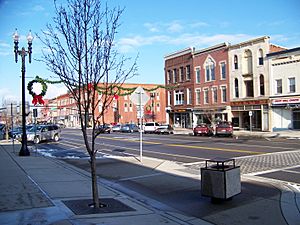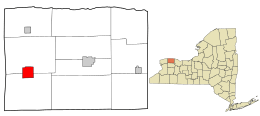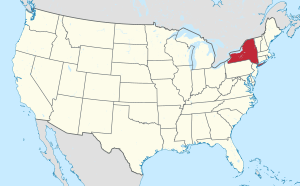Medina, New York facts for kids
Quick facts for kids
Medina
|
|
|---|---|

Main and Center Street junction
|
|

Location in Orleans County and the state of New York.
|
|

Location of New York in the United States
|
|
| Country | |
| State | |
| County | Orleans |
| Settled | 1817 |
| Incorporated | 1832 |
| Government | |
| • Type | Empire |
| Area | |
| • Total | 3.38 sq mi (8.74 km2) |
| • Land | 3.30 sq mi (8.54 km2) |
| • Water | 0.08 sq mi (0.20 km2) |
| Elevation | 525 ft (160 m) |
| Highest elevation
(S border of village near SW corner along NY 31)
|
590 ft (180 m) |
| Lowest elevation
(Glenwood Lake)
|
453 ft (138 m) |
| Population
(2020)
|
|
| • Total | 6,047 |
| • Density | 1,832.98/sq mi (707.76/km2) |
| Time zone | UTC-5 (EST) |
| • Summer (DST) | UTC-4 (EDT) |
| ZIP Code |
14103
|
| Area code(s) | 585 |
| FIPS code | 36-46415 |
| GNIS feature ID | 0956905 |
| Wikimedia Commons | Medina, New York |
| Website | www.VillageMedina.org |
Medina is a village in Orleans County, New York, United States. It is about 10 miles south of Lake Ontario. In 2020, about 6,047 people lived there. This makes it the most populated place in the county.
The village got its name from Ebenezer Mix, who surveyed the area. Medina is part of the larger Rochester area. Its zip code, 14103, covers Medina and the nearby towns of Ridgeway and Shelby.
Medina grew a lot after the Erie Canal was built. The canal has a bend in Medina, which created a special spot for boats to stop. This spot became a busy center for businesses. Mills were also built on Oak Orchard Creek to use the water power. Farmers in the area grew a lot of fruit. They sent it to big cities like New York City using the canal. By the early 1900s, Medina was a busy industrial town.
Medina is about an hour's drive from two major cities: Rochester to the east and Buffalo to the west. It's also about 30 minutes from the smaller cities of Batavia and Lockport.
Contents
Medina's Story: A Look at Its Past
Joseph Ellicott, who worked for the Holland Land Company, once owned land that is now part of Medina. When the Erie Canal opened through Medina, the village became a hub for trade. It was busy with boats carrying goods and people.
The Village of Medina officially became a village on March 3, 1832. It was set up within the towns of Ridgeway and Shelby. The first newspaper, The Medina Herald, was also published that year. In 1852, the railroad came to Medina, and train travel became very popular.
Early Businesses in Medina
Medina's first known business was an ashery. This was a place that turned hardwood ash into useful products like lye. This was important because the area had many trees that needed to be cleared for the village and the Erie Canal. Most early businesses used the Erie Canal for transportation.
Mills and Factories
Medina had many different types of mills over the years.
- Grain and flour mills were very important. They were built as early as 1830.
- Stave mills made wood strips for barrels in the 1870s.
- Sawmills created lumber for other local industries.
The demand for flour meant many barrels were needed to ship it on the Erie Canal.
Metal Foundries
Foundries are places where metal is melted and shaped.
- The Bignall Foundry started selling iron pumps and sinks in 1861.
- Later, it joined with two other local foundries, A.L. Swett Company and Beach & Co. They became the Central Foundry Company in 1899. This company made soil pipes.
- A.L Swett Iron Works made special hardware items from 1871 into the 1920s.
- Beach & Co made plumbing supplies starting in the 1880s.
Furniture Making
Medina also had big furniture companies.
- The Maher Brothers started their furniture business in 1882. Their family ran it until 1928.
- S.A. Cook opened his furniture business around 1882. Their Morris chair was very popular.
- The Empire Couch Company moved to Medina in 1902. They stayed in business through the widening of the canal. However, they closed during the Great Depression in 1935.
Medina Sandstone: A Famous Local Stone
Medina is famous for its Medina Sandstone. This stone was used in many buildings across the region.
- You can see it in the "million dollar staircase" at the New York State Capitol in Albany.
- It was also used in the Richardson Olmsted Complex in Buffalo.
- Buildings at the University of Rochester and Cornell University also feature this stone.
- Medina Sandstone comes in colors from light grey to deep reddish-brown.
The first business to quarry sandstone opened in 1837. At its busiest, sandstone quarries were a top employer in the county. They had up to 2,000 workers. But after World War 1, cheaper building materials became available. This caused the popularity of Medina Sandstone to decline.
Pearl Street Armory: A Historic Building
In 1901, a State Armory was built using Medina Sandstone. It was home to Company F, a military unit. This unit served in World War I and World War II. The Armory closed in 1977. Today, the building houses the YMCA. A statue was put in front of the building in 2019 to honor Company F.
World War II Prisoner of War Camp
During World War II, Medina's Heinz factory had a Prisoner of War (POW) camp.
- From 1943 to 1946, it held soldiers from Italy and Germany.
- In September 1943, 71 Italian soldiers arrived. They worked at the Heinz factory, on local farms, and in other factories.
- In May 1944, German soldiers replaced the Italians.
- Once, the German prisoners went on strike. They wanted to smoke inside the factory. After their belongings were taken away, they returned to work the next day.
- The camp closed in 1946. All prisoners were sent back to Germany. At its peak, the camp held up to 300 soldiers.
Recent Times in Medina
In 2015, people in Medina voted to keep it an official village. This happened even though it had high property taxes.
Several buildings and areas in Medina are listed on the National Register of Historic Places. This means they are important historical sites. These include:
- The Main Street Historic District
- The Medina Armory
- The United States Post Office
- The Payjack Chevrolet Building (added in 2012)
- Boxwood Cemetery (added in 2015)
Medina's Location and Landscape
Medina is located at 43°13′11″N 78°23′24″W / 43.21972°N 78.39000°W. The village covers about 3.3 square miles (8.7 square kilometers). Most of this area is land, with a small part being water.
Medina is where several important roads meet:
- NYS Route 31 (east-west)
- NYS Route 63 (north-south)
- NYS Route 31E and NYS Route 31A also start here.
Medina's Population
| Historical population | |||
|---|---|---|---|
| Census | Pop. | %± | |
| 1870 | 2,821 | — | |
| 1880 | 3,632 | 28.7% | |
| 1890 | 4,492 | 23.7% | |
| 1900 | 4,716 | 5.0% | |
| 1910 | 5,683 | 20.5% | |
| 1920 | 6,011 | 5.8% | |
| 1930 | 6,071 | 1.0% | |
| 1940 | 5,871 | −3.3% | |
| 1950 | 6,179 | 5.2% | |
| 1960 | 6,681 | 8.1% | |
| 1970 | 6,415 | −4.0% | |
| 1980 | 6,392 | −0.4% | |
| 1990 | 6,686 | 4.6% | |
| 2000 | 6,415 | −4.1% | |
| 2010 | 6,065 | −5.5% | |
| 2020 | 6,047 | −0.3% | |
| U.S. Decennial Census | |||
In 2000, Medina had 6,415 people. About 88% of the people were White, and about 7.5% were African American. About 3.8% of the population was Hispanic or Latino.
Places of Worship
Medina has been home to many different groups of people over the years. This is shown by the variety of churches built.
- St. John's Episcopal Church was the first, built in 1828.
- Other churches like First United Presbyterian, First Baptist, United Methodist, and St. Mary's Roman Catholic followed.
- German immigrants built Trinity Evangelical Lutheran and St. Peter Evangelical Lutheran in the 1880s and 1890s.
- The Polish community built Sacred Heart of Jesus Christ Church in 1910.
- The African American community built Glad Tidings Missionary Baptist Church in 1930.
- More recently, other churches and religious centers have opened.
Medina is even mentioned in Ripley's Believe It or Not for St. John's Episcopal Church. It's known as the "Church in the Middle of the Road."
Medina's Economy and Tourism
Medina has many businesses, from local shops to international companies. It is also becoming a popular place for tourists. This is thanks to its historic downtown and its location on the Niagara Wine Trail.
Local Businesses
Here are some of the larger businesses in the Medina area:
- Baxter International: This company makes many products for healthcare, like IV pumps.
- Velocitii: They help other companies with customer support and sales. They opened in 2014 and employ over 50 people.
- Brunner International: This family-owned business makes parts for commercial vehicles, buses, and trailers.
- Hinspergers Poly Industries: They make protective covers out of polyethylene.
- Pride Pak Canada: This company packages salads and fresh-cut vegetables. They opened a facility in Medina in 2016.
- Takeform: This company makes signs and is based in Medina. They have won many awards.
- Western New York Energy: This plant turns corn into ethanol. It started production in 2007. In 2022, they expanded to make alcohol for industrial and medical uses.
Things to Do and See
Medina is growing as a tourist spot. It has events, restaurants, and a charming small-town feel.
Arts and Fun
Medina offers many cultural and fun activities:
- Into the Enigma: An escape room where you solve puzzles to get out.
- Medina Railroad Museum: One of the biggest railroad and toy train museums in New York.
- Ripley's Believe It or Not also mentions "the Culvert" in Medina. It's the only place where the Erie Canal goes over an active road.
You can see new modern art and murals behind the historic downtown buildings.
- The first mural, called the 'Canalligator', was painted in July 2020.
- Other murals followed, showing geometric characters, a traveler with pets, and local flowers.
- All these murals are behind buildings on the northwest side of Main Street.
The Orleans Renaissance Group is a group of volunteers. They support arts, culture, and history in Medina. They host concerts, farmers' markets, and help restore historic buildings like Bent's Opera House.
Medina's downtown area is a historic district. This means it's a special place with important old buildings. Bent's Opera House is part of this district. It's a historic place for live shows.
Medina has many restaurants, pizza shops, and diners. It also has one stop on the Niagara Wine Trail: Leonard Oakes Winery. They have won awards for their wines.
Learning in Medina
Medina has two schools for students from kindergarten to 12th grade:
- The Medina Central School District includes Oak Orchard Primary, Clifford Wise Intermediate, and Medina High School. All three are on the same campus.
- The Orleans County Christian School is a private school.
A branch of Genesee Community College also opened in Medina in 2007.
The community is served by the Lee-Whedon Memorial Library.
Fun and Events in Medina
Parks to Explore
Medina has seven public parks. They are open from dawn until dusk. Most parks have swings, slides, and picnic tables.
- Gulf Street Park
- Gwinn Street Park
- John E Butts Memorial Park: Has a skateboard park and baseball fields.
- Medina Canal Basin Park: Offers places for boats to dock, electricity, and water.
- Pine Street Park: A playground with a splashpad.
- Rotary Park: Has an All Season House, used by Santa in winter.
- State Street Park: Has a gazebo.
Yearly Events
Medina hosts several fun events each year:
- Ale in Autumn: Walk downtown and try different beers.
- Beggar's Night: Trick-or-treating for kids under 10 at Main Street businesses.
- Olde Tyme Christmas and Parade of Lights: Held the Saturday after Thanksgiving. Enjoy shopping, activities, fireworks, and a parade of lights.
- Wine about Winter: Walk around Medina and sample local wines.
- Sweets in Summer: Taste sweets throughout the Historic Downtown area.
- Faery Festival: Activities, dancing, and a parade for children.
Local News
Medina has had several newspapers over the years. These include The Medina Herald, The Medina Tribune, and The Medina Register. The Medina Journal-Register was the last one, but it closed in May 2014.
Interesting Facts About Medina
- One of Medina's oldest homes was built in the early 1820s on Eagle Street. It was torn down in 2012.
- The Carl Company was a department store that started in Medina as a dry goods shop.
Famous People From Medina
- John J. Bagley: A former Governor of Michigan.
- Julie Berry (author): A children's author.
- Silas M. Burroughs: A former US Congressman.
- Silas M. Burroughs: A famous pharmacist, son of the Congressman.
- Frances Folsom Cleveland Preston: A former First Lady, who went to high school in Medina.
- Carl Fischer: A former Major League Baseball player.
- John E. Butts: A U.S. Army officer who received the Medal of Honor in WWII.
- John Ford: A New York State Senator.
- George Kennan: An author, lecturer, and traveler.
- Craig Wilson: A columnist for USA Today.
- Melanie Green: An amateur golfer.
See also
 In Spanish: Medina (Nueva York) para niños
In Spanish: Medina (Nueva York) para niños


